MybatisPlus
1、简介
MyBatisPlus可以节省我们大量的时间,所有CRUD代码都可以自动完成
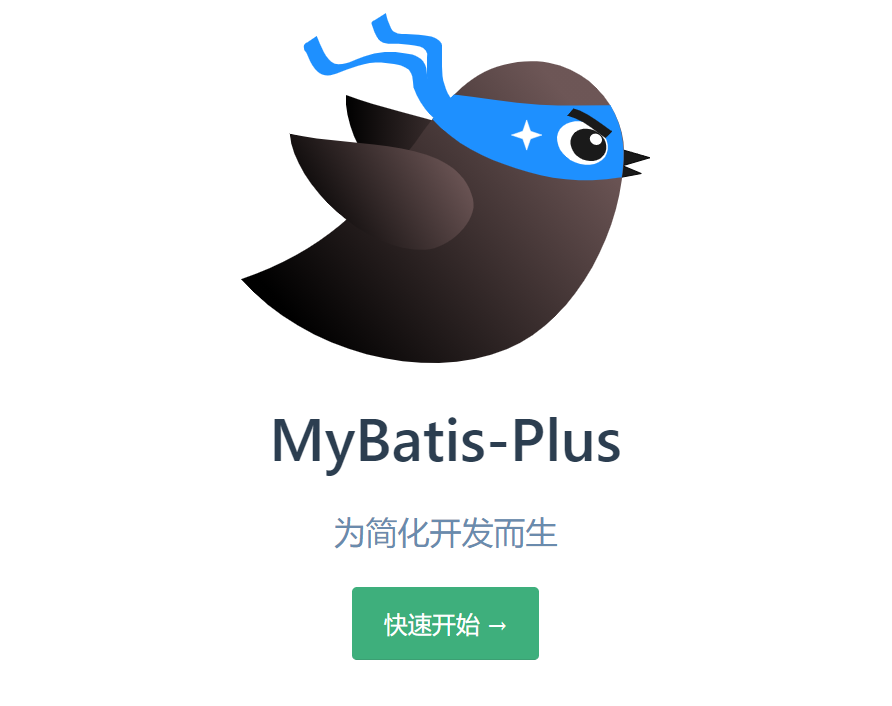
2、特性
- 无侵入:只做增强不做改变,引入它不会对现有工程产生影响,如丝般顺滑
- 损耗小:启动即会自动注入基本 CURD,性能基本无损耗,直接面向对象操作
- 强大的 CRUD 操作:内置通用 Mapper、通用 Service,仅仅通过少量配置即可实现单表大部分 CRUD 操作,更有强大的条件构造器,满足各类使用需求
- 支持 Lambda 形式调用:通过 Lambda 表达式,方便的编写各类查询条件,无需再担心字段写错
- 支持主键自动生成:支持多达 4 种主键策略(内含分布式唯一 ID 生成器 - Sequence),可自由配置,完美解决主键问题
- 支持 ActiveRecord 模式:支持 ActiveRecord 形式调用,实体类只需继承 Model 类即可进行强大的 CRUD 操作
- 支持自定义全局通用操作:支持全局通用方法注入( Write once, use anywhere )
- 内置代码生成器:采用代码或者 Maven 插件可快速生成 Mapper 、 Model 、 Service 、 Controller 层代码,支持模板引擎,更有超多自定义配置等您来使用
- 内置分页插件:基于 MyBatis 物理分页,开发者无需关心具体操作,配置好插件之后,写分页等同于普通 List 查询
- 分页插件支持多种数据库:支持 MySQL、MariaDB、Oracle、DB2、H2、HSQL、SQLite、Postgre、SQLServer 等多种数据库
- 内置性能分析插件:可输出 Sql 语句以及其执行时间,建议开发测试时启用该功能,能快速揪出慢查询
- 内置全局拦截插件:提供全表 delete 、 update 操作智能分析阻断,也可自定义拦截规则,预防误操作
3、快速入门
- 导入对应的依赖
- 研究依赖如何配置
- 代码如何编写
- 提高扩展技术能力
步骤
1.创建数据库mybatisplus,创建数据表user
DROP TABLE IF EXISTS user;
CREATE TABLE user
(
id BIGINT(20) NOT NULL COMMENT '主键ID',
name VARCHAR(30) NULL DEFAULT NULL COMMENT '姓名',
age INT(11) NULL DEFAULT NULL COMMENT '年龄',
email VARCHAR(50) NULL DEFAULT NULL COMMENT '邮箱',
PRIMARY KEY (id)
);
插入数据
DELETE FROM user;
INSERT INTO user (id, name, age, email) VALUES
(1, 'Jone', 18, 'test1@baomidou.com'),
(2, 'Jack', 20, 'test2@baomidou.com'),
(3, 'Tom', 28, 'test3@baomidou.com'),
(4, 'Sandy', 21, 'test4@baomidou.com'),
(5, 'Billie', 24, 'test5@baomidou.com');
2.编写springboot项目,导入依赖
<dependency>
<groupId>mysql</groupId>
<artifactId>mysql-connector-java</artifactId>
</dependency>
<dependency>
<groupId>com.baomidou</groupId>
<artifactId>mybatis-plus-boot-starter</artifactId>
<version>3.4.3.2</version>
</dependency>
3.连接数据库
spring:
datasource:
username: root
password: 123456
#?serverTimezone=UTC解决时区的报错
url: jdbc:mysql://localhost:3306/mybatisplus?useUnicode=true&characterEncoding=utf-8
driver-class-name: com.mysql.cj.jdbc.Driver
4.pojo-dao
(连接mybatis,配置mapper.xml文件【之前的操作】)-service-controller
现在不需要写mapper.xml了
写pojo层
@Data
@AllArgsConstructor
@NoArgsConstructor
public class User {
private Long id;
private String name;
private Integer age;
private String email;
}
写Mapper层,继承BaseMapper
//在对应的Mapper上面实现基本的类BaseMapper
//@Repository//代表持久层这里写了@Respository没写@MApper的话springboot的主启动类要加@MapperScan("com.badwei.mybatisplus.mapper"),这些也可以直接使用一个@Mapper代替
@Mapper
public interface UserMapper extends BaseMapper<User> {
//所有的CRUD都已经编写完成
}
5.测试类中测试
@SpringBootTest
class MybatisplusApplicationTests {
@Autowired
private UserMapper userMapper;
@Test
void contextLoads() {
//查询全部用户
List<User> users = userMapper.selectList(null);
users.forEach(System.out::println);
}
}

4、配置日志
# 配置日志
mybatis-plus:
configuration:
log-impl: org.apache.ibatis.logging.stdout.StdOutImpl
测试,有了日志
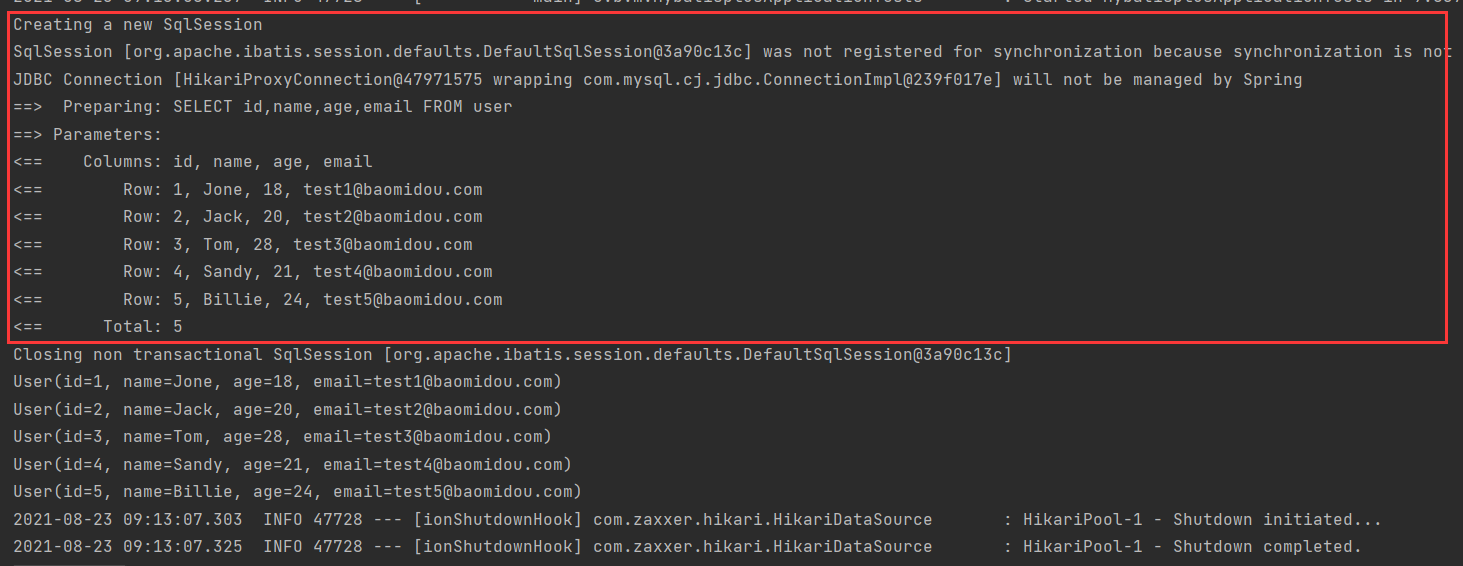
5、CRUD拓展
5.1*、插入操作:
@Test
public void test1(){
User user = new User("lxw",20,"777@qq.com");
int insert = userMapper.insert(user);//帮我们自动生成id
System.out.println(insert);
System.out.println(user);
}
主键生成策略:分布式系统唯一id生成:https://www.cnblogs.com/haoxinyue/p/5208136.html
5.2、雪花算法:
snowflake是Twitter开源的分布式ID生成算法,结果是一个long型的ID。其核心思想是:使用41bit作为毫秒数,10bit作为机器的ID(5个bit是数据中心,5个bit的机器ID),12bit作为毫秒内的流水号(意味着每个节点在每毫秒可以产生 4096 个 ID),最后还有一个符号位,永远是0。具体实现的代码可以参看https://github.com/twitter/snowflake。雪花算法支持的TPS可以达到419万左右(2^22*1000)。
雪花算法在工程实现上有单机版本和分布式版本。单机版本如下,分布式版本可以参看美团leaf算法:https://github.com/Meituan-Dianping/Leaf
5.3、主键自增
1.在实体类字段上加入@TableId(type = IdType.AUTO)
@TableId(type = IdType.AUTO)
private Long id; // 对应数据库中的主键(uuid,自增id,雪花算法,redis,zookeeper)
private String name;
private Integer age;
private String email;
2.数据库字段一定要是自增!

3.测试
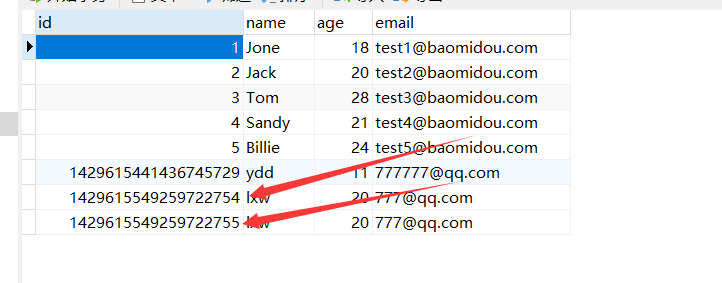
源码解释
参考文档:https://www.cnblogs.com/mark5/p/14268122.html
public enum IdType {
AUTO(0), //数据库id自增
NONE(1), //未设置主键
INPUT(2), //手动输入
ASSIGN_ID(3), //雪花算法
ASSIGN_UUID(4); //排除中划线的UUID
}
5.4*、更新操作:
@Test
public void test2(){
User user = new User();
// 通过条件自动拼接动态SQL
user.setId(5L);
user.setName("666");
// 注意,updateById传入的是一个user
int i = userMapper.updateById(user);
System.out.println(i);
}
所有sql操作都是动态配置的
5.5、自动填充(create_time , update_time)
创建时间 . 修改时间! 这些个操作都是自动化完成的,我们不希望手动更新!
阿里巴巴开发手册:所有的数据库表:gmt_create .gmt_modified几乎所有的表都要配置上!而且需要自动化!
方式一:数据库级别【不推荐】
1.在表中新增字段 create_time , update_time【选择自动更新】

2.再次测试插入方法,我们需要先把实体类同步
private Date creatTime;
private Date updateTime;
3.测试(执行一次更新)
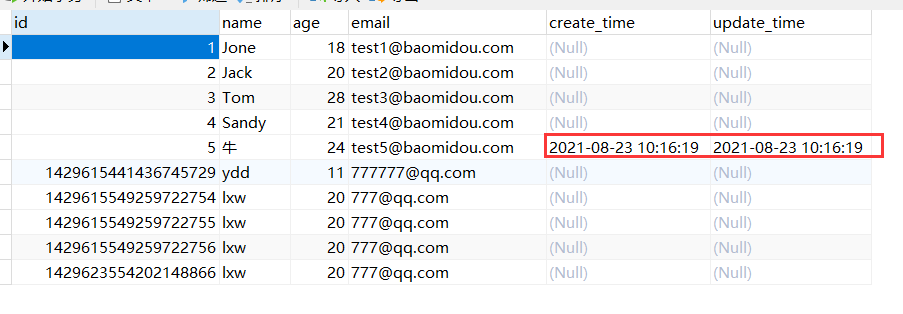
方式二:代码级别
1.取消勾选数据库自动更新
2.实体类字段上增加注解
@TableField(fill = FieldFill.INSERT)
private LocalDateTime creatTime; //官网新方法用了LocalDateTime,我们这里改一下
@TableField(fill = FieldFill.INSERT_UPDATE)
private LocalDateTime updateTime;
3.编写处理器来处理这个注解
@Slf4j
@Component //要把处理器组件加到IOC容器中
public class MyMetaObjectHandler implements MetaObjectHandler {
//插入时的填充策略
@Override
public void insertFill(MetaObject metaObject) {
log.info("start insert fill...........");
this.strictInsertFill(metaObject, "createTime", LocalDateTime.class, LocalDateTime.now());
this.strictUpdateFill(metaObject, "updateTime", LocalDateTime.class, LocalDateTime.now());
}
//更新时的填充策略
@Override
public void updateFill(MetaObject metaObject) {
log.info("start update fill...........");
this.strictUpdateFill(metaObject, "updateTime", LocalDateTime.class, LocalDateTime.now());
}
}
4.测试插入,更新,观察时间

5.6、乐观锁
乐观锁,悲观锁
乐观锁:十分乐观,他总是认为不会出现问题,无论干什么都不去上锁!如果出现了问题,再次更新值测试
悲观锁:十分悲观,他总是认为出现问题,无论干什么都会上锁!再去操作!
version 、new version【版本】
乐观锁机制:
当要更新一条记录的时候,希望这条记录没有被别人更新
乐观锁实现方式:
- 取出记录时,获取当前version
- 更新时,带上这个version
- 执行更新时, set version = newVersion where version = oldVersion
- 如果version不对,就更新失败
1.添加version字段,指定默认值为1
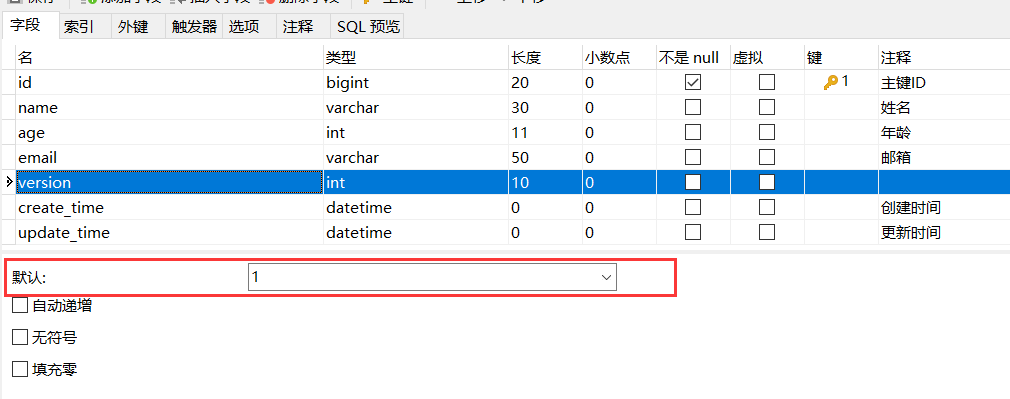

2.实体类中天街version字段,并加入@Version注解
@Version //乐观锁的注解
private Integer version;
3.注册组件
@EnableTransactionManagement
@Configuration //配置类
public class MybatisPlusConfig {
@Bean
public MybatisPlusInterceptor mybatisPlusInterceptor() {
MybatisPlusInterceptor interceptor = new MybatisPlusInterceptor();
interceptor.addInnerInterceptor(new OptimisticLockerInnerInterceptor());
return interceptor;
}
}
4..测试
//测试乐观锁成功
@Test
public void test3(){
User user = userMapper.selectById(1L);
user.setName("lxw");
userMapper.updateById(user);
}
//测试乐观锁失败
@Test
public void test4(){
//线程1
User user = userMapper.selectById(1L);
user.setName("lxw111");
//模拟另一个线程2执行插队
User user2 = userMapper.selectById(1L);
user2.setName("lxw222");
userMapper.updateById(user2);
userMapper.updateById(user); //如果没有乐观锁,就会覆盖插队后的值
//执行结果为lxw222,因为执行完插队线程2后,version变了,所以线程1执行失败
}
结果:

5.7*、查询操作:
//简单查询
@Test
public void test5(){
User user = userMapper.selectById(1L);
System.out.println(user);
}
//测试批量查询
@Test
public void test6(){
List<User> users = userMapper.selectBatchIds(Arrays.asList(1, 2, 3));
users.forEach(System.out::println);
}
// 按条件查询之一:使用map操作
@Test
public void test7(){
Map<String, Object> map = new HashMap<>();
//自定义查询
map.put("name","lxw222");
map.put("age",18);
List<User> users = userMapper.selectByMap(map);
users.forEach(System.out::println);
}
5.8、分页查询
分页插件
// 最新版
@Bean
public MybatisPlusInterceptor mybatisPlusInterceptor() {
MybatisPlusInterceptor interceptor = new MybatisPlusInterceptor();
interceptor.addInnerInterceptor(new PaginationInnerInterceptor(DbType.MYSQL));//把这行加入到之前的代码中
return interceptor;
}
分页测试:
//测试分页查询
@Test
public void test8(){
//参数一:当前页
//参数二:页面大小
Page<User> page = new Page<>(2,5);
userMapper.selectPage(page,null);
page.getRecords().forEach(System.out::println);
}
查询的时候也是先count *查询总数
然后limit分页

5.9、删除
基本的删除操作
//测试删除
@Test
public void test9(){
userMapper.deleteById(1L);
}
//通过id批量结束
@Test
public void test10(){
userMapper.deleteBatchIds(Arrays.asList(1429615549259722754L,1429615549259722755L));
}
//通过map删除
@Test
public void test11(){
HashMap<String, Object> map = new HashMap<>();
map.put("name","lxw");
map.put("age",20);
userMapper.deleteByMap(map);
}
5.10、逻辑删除
-
物理删除:从数据库中直接移除
-
逻辑删除::在数据库中没有被移除,而是通过一个变量来让他失效! deleted=0=>deleted=1
-
附录:
- 逻辑删除是为了方便数据恢复和保护数据本身价值等等的一种方案,但实际就是删除。
- 如果你需要频繁查出来看就不应使用逻辑删除,而是以一个状态去表示。
测试:
1.在数据表中增加一个deleted字段,让它默认为0,表示未删除

2.在实体类中增加deleted字段,和注解@TableLogic
@TableLogic //逻辑删除注解
private Integer deleted;
3.application.yaml配置逻辑删除
mybatis-plus:
global-config:
db-config:
logic-delete-field: delete # 全局逻辑删除的实体字段名(since 3.3.0,配置后可以忽略不配置步骤2)
logic-delete-value: 1 # 逻辑已删除值(默认为 1)
logic-not-delete-value: 0 # 逻辑未删除值(默认为 0)
测试
userMapper.deleteById(2L);
执行的是删除delete操作,但是执行的其实是更新操作update
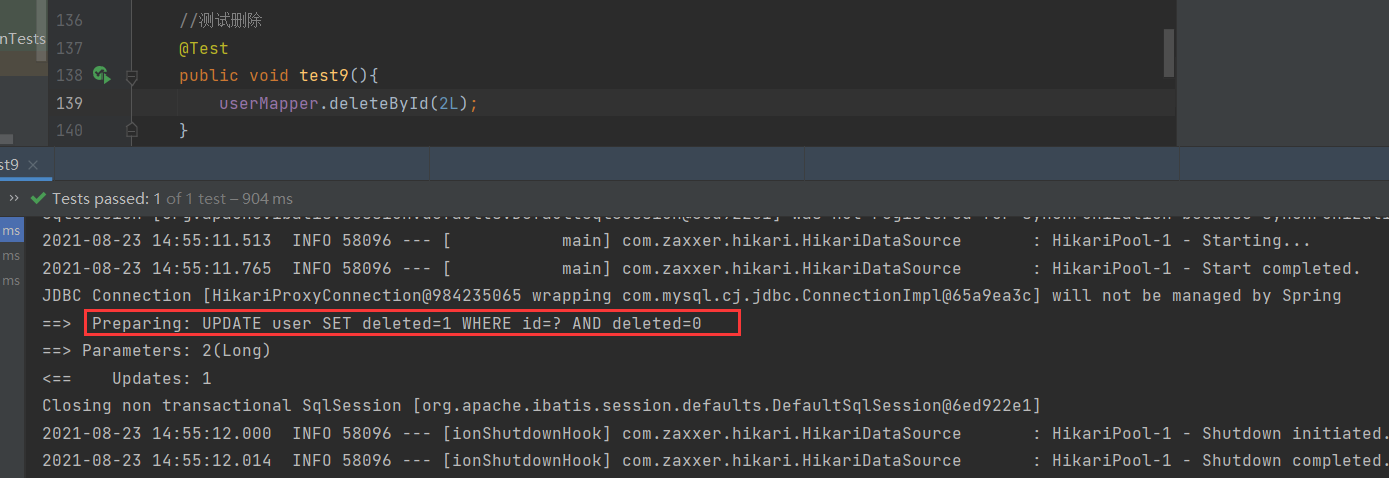
查看数据库

之后查询的时候,会自动拼接where deleted=0,不会查询到被逻辑删除的用户
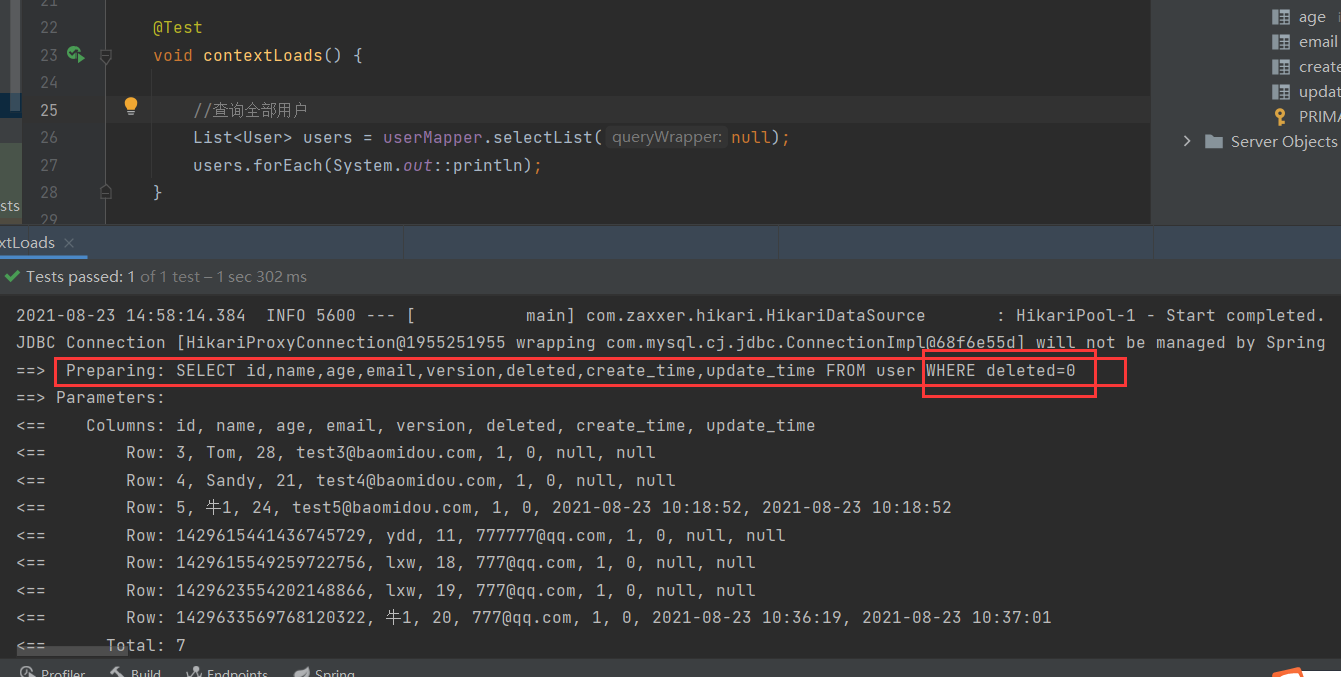
6、性能分析插件
慢sql,测试druid之类的测试
mybatisplus也提供了执行 SQL 分析打印
1.导入p6spy 依赖
<dependency>
<groupId>p6spy</groupId>
<artifactId>p6spy</artifactId>
<version>3.9.1</version>
</dependency>
2.配置application.yaml
修改url和driver-class-name
# 数据库连接
spring:
datasource:
username: root
password: 123456
#?serverTimezone=UTC解决时区的报错
url: jdbc:p6spy:mysql://localhost:3306/mybatisplus?useUnicode=true&characterEncoding=utf-8
driver-class-name: com.p6spy.engine.spy.P6SpyDriver
# driver-class-name: com.mysql.cj.jdbc.Driver
3.新建文件spy.properties
#3.2.1以上使用
modulelist=com.baomidou.mybatisplus.extension.p6spy.MybatisPlusLogFactory,com.p6spy.engine.outage.P6OutageFactory
#3.2.1以下使用或者不配置
#modulelist=com.p6spy.engine.logging.P6LogFactory,com.p6spy.engine.outage.P6OutageFactory
# 自定义日志打印
logMessageFormat=com.baomidou.mybatisplus.extension.p6spy.P6SpyLogger
#日志输出到控制台
appender=com.baomidou.mybatisplus.extension.p6spy.StdoutLogger
# 使用日志系统记录 sql
#appender=com.p6spy.engine.spy.appender.Slf4JLogger
# 设置 p6spy driver 代理
deregisterdrivers=true
# 取消JDBC URL前缀
useprefix=true
# 配置记录 Log 例外,可去掉的结果集有error,info,batch,debug,statement,commit,rollback,result,resultset.
excludecategories=info,debug,result,commit,resultset
# 日期格式
dateformat=yyyy-MM-dd HH:mm:ss
# 实际驱动可多个
#driverlist=org.h2.Driver
# 是否开启慢SQL记录
outagedetection=true
# 慢SQL记录标准 2 秒
outagedetectioninterval=2
测试一个查询select *代码:

7、条件构造器
用到的话去看官网https://mp.baomidou.com/guide/wrapper.html#abstractwrapper
@SpringBootTest
public class MyTest {
@Autowired
private UserMapper userMapper;
//多条件查询
@Test
void contextLoads() {
//查询name不为空,邮箱不为空的用户,年龄>=20
QueryWrapper<User> wrapper = new QueryWrapper<>();
wrapper.isNotNull("name")
.isNotNull("email")
.ge("age",20);
userMapper.selectList(wrapper).forEach(System.out::println);
}
//查询一个用户
@Test
public void test2(){
// 查询狂神说
QueryWrapper<User> wrapper = new QueryWrapper<>();
wrapper.eq("name","ydd");
User user = userMapper.selectOne(wrapper); // 查询一个用户
System.out.println(user);
}
//查询数量count
@Test
public void test3(){
// 查询狂神说
QueryWrapper<User> wrapper = new QueryWrapper<>();
wrapper.eq("name","lxw");
Long count = userMapper.selectCount(wrapper); // 查询结果数
System.out.println(count);
}
// 模糊查询
@Test
public void test4(){
QueryWrapper<User> wrapper = new QueryWrapper<>();
wrapper.notLike("name","w").likeRight("email","t");
List<Map<String, Object>> maps = userMapper.selectMaps(wrapper);
maps.forEach(System.out::println);
}
//子查询
@Test
public void test5(){
QueryWrapper<User> wrapper = new QueryWrapper<>();
//在id中子查询IN
wrapper.inSql("id","select id from user where id<4");
List<Map<String, Object>> maps = userMapper.selectMaps(wrapper);
maps.forEach(System.out::println);
}
//排序
@Test
public void test6() {
QueryWrapper<User> wrapper = new QueryWrapper<>();
// 通过id进行飘絮
wrapper.orderByDesc("id");
List<Map<String, Object>> maps = userMapper.selectMaps(wrapper);
maps.forEach(System.out::println);
}
}
8、代码自动生成器
AutoGenerator 是 MyBatis-Plus 的代码生成器,通过 AutoGenerator 可以快速生成 Entity、Mapper、Mapper XML、Service、Controller 等各个模块的代码,极大的提升了开发效率。
查看官方文档:https://mp.baomidou.com/guide/generator.html#%E4%BD%BF%E7%94%A8%E6%95%99%E7%A8%8B




评论区